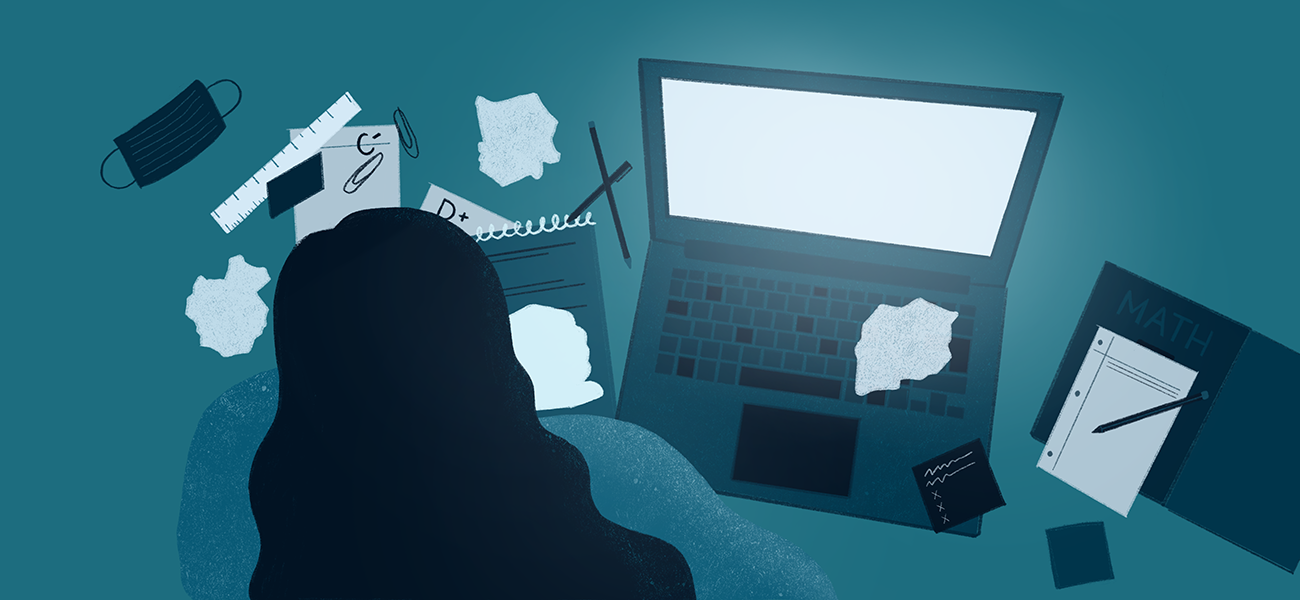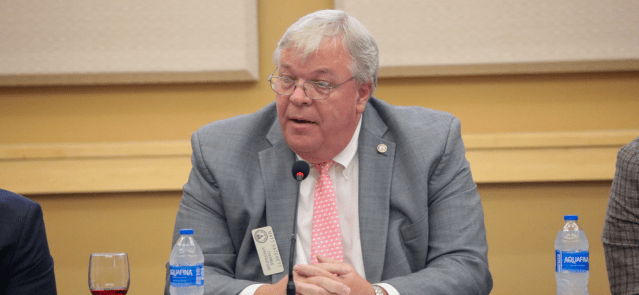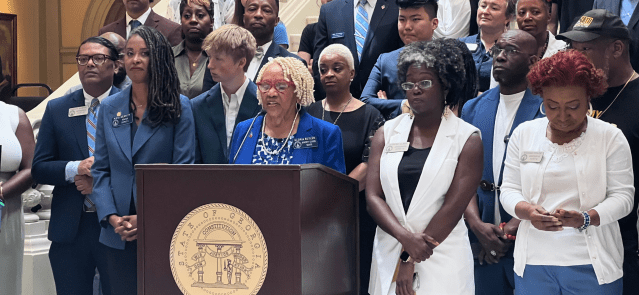Stay ahead of the curve as a political insider with deep policy analysis, daily briefings and policy-shaping tools.
Request a Demo
Illustration by Brittney Phan (State Affairs)
- State audit shows student test scores and grades fell across Georgia during the 2020-21 school year.
- Enrollment fell by tens of thousands of students in Fall 2020 after schools closed and classes moved online.
- The federal government is sending $4.2 billion to Georgia state and local school officials to address learning loss.
The dust has started settling on the damage done to Georgia’s 1.7 million public school students from COVID-19 – and the initial picture looks rough.
Across the Peach State, teachers report their students have fallen months behind in their studies since the pandemic broke out. Thousands fewer students passed math and language-arts courses last school year, particularly younger kids. Roughly 1 in 40 students dropped out of public schools or opted to homeschool in Fall 2020. Many haven’t returned.
Those findings come from a recent state audit that sheds light on the pandemic fallout for Georgia’s more-than 2,000 public k-12 schools. While state officials pushed back on some findings, local education advocates say the auditors’ insights largely square with what they hear from teachers, students and parents still grinding through COVID-19 outbreaks.
“It’s just been a really uneven period of time where it’s been hard to have a level of consistency you need to have kids in classrooms,” said Craig Harper, executive director of the Professional Association of Georgia Educators (PAGE). “It’s hard to make that up.”
Around 60,000 more Georgia students failed math and English classes in the 2020-21 school year compared to before the pandemic, according to the audit’s findings. The largest fail rates occurred in 3rd through 8th grades – critical ages for building foundational skills in preparation for college and beyond. Thousands of students lost ground in language arts, math and reading at grade level, state data shows.

Georgia middle schoolers have struggled to keep up with reading, writing and arithmetic classes during the pandemic. (Credit: Beau Evans for State Affairs)
The state’s data likely doesn’t show the full picture of how far Georgia students are lagging in their courses, the audit warned. Hundreds of thousands fewer students took the Georgia Milestones year-end exams that help educators track academic progress. State officials gutted the annual exams to give stressed-out teachers and students a break.
Learn more about the money challenges Georgia faces when it comes to improving struggling schools in our story, “Money, Poverty and the Pitfalls of Georgia’s Public Schools.”
Meanwhile, total enrollment fell by nearly 40,000 students between the 2019 and 2020 Fall semesters, especially among kindergartens. Local districts that kept students in online classes long into last school year also saw big enrollment drops, the audit found. Many students switched to private schools and homeschool, the audit says. Others likely just dropped out.
“It’s easier for kids who have participated in the face-to-face option,” Carrie Booher, assistant superintendent at Henry County Schools, said in PAGE’s June newsletter. “Those who have participated in the virtual option have bigger gaps and we know we will have to apply more intervention.”
Virtual learning threw a big wrench in the equation. Just 16% of teachers surveyed in the audit considered online classes an effective format. Many kids simply tuned out during chatroom lectures, while more than a quarter of Georgia’s students – mostly in rural areas – were hard pressed to even get reliable internet without mobile hotspots on loan from the state, according to the audit.
Read about how most Georgia colleges and universities have historically charged more tuition for online classes than in-person classes in our story, “Why Most Georgia Colleges Charged More – Much More – for Online Classes.”
Barely half of Georgia’s roughly 2,000 schools even gave students the option of remote learning to start the 2022 Spring semester – indicating online classes have gotten the cold shoulder from many parents and administrators, despite COVID-19’s highly contagious Omicron variant that’s still flaring across the state.

State public-health data shows COVID-19 positive case rates have spiked in recent weeks amid a surge from the Omicron variant. (Credit: Georgia Department of Public Health)
State education officials haven’t shied away recognizing times are tough for Georgia students.
“Without question, Georgia students experienced lost learning opportunities as a result of the pandemic – including statewide school closures in 2020 and rolling quarantines and shifting instructional models continuing into 2021,” officials said in response to the state audit.
Still, it’s not all doom-and-gloom in Georgia schools. State officials credited letting local districts decide whether to open schools for in-person classes as key to boosting college-acceptance test scores and keeping graduation rates steady last year.
Georgia students’ declining grades were “in line with national trends,” officials said, “although Georgia likely fared better than other states which closed schools for the majority of the 2020-21 school year – as evidenced by Georgia’s graduating classes of 2020 and 2021 exceeding the national average on the SAT and ACT.”

Few Georgia schools are requiring virtual learning for students to start the 2022 Spring semester. (Credit: Beau Evans for State Affairs)
Officials also took issue with the audit’s bleak assessment of academic declines, noting auditors based much of their findings on surveys from 725 teachers – less than 1% of the state’s nearly 120,000 teachers.
Now, state and local school officials are eying around $4.2 billion in federal pandemic aid to address so-called learning loss over the next few years. How they use that money could make a big difference in how swiftly Georgia gets its students back on track.
Read about how state officials plan to handle Georgia’s upcoming rounds of federal pandemic relief in our story, “Georgia’s Governor has Nearly $5 Billion in Pandemic Relief to Spend. How Will He Use It?”
Many districts have already started pumping funds into summer school and more virtual options, on top of more regular class hours for students to catch up. Some schools added counselors and special tutors to work with struggling kids. Others plan on hiring more teachers and one-on-one staff to focus on the propping up younger kids who stumbled the most.

State School Superintendent Richard Woods heads Georgia’s state agency overseeing public k-12 and charter schools. (Credit: Georgia Department of Education)
To pay for those things, Georgia’s public schools are set for $3.8 billion in the federal American Rescue Plan to help reverse learning losses from the pandemic. The state education agency will get an additional $425 million. Officials to spend $85 million on summer and after-school programs; $77 million to create a new office focused on boosting school performance in rural Georgia; and $68 million on teacher recruitment and retention, including a one-time pay bonus, the audit says.
The funds should bring a shot in the arm to Georgia schools – but state auditors have questions. They’re concerned state and local officials haven’t nailed down enough specifics on how they’ll spend those dollars. Some local schools already have “lacked defined plans for evaluating impact” of the federal aid, the recent audit found.
“Given the learning loss that has occurred, it is critical that local school systems make the best possible use of this one-time funding,” the state audit says. State officials told auditors it is largely up to local officials to decide how they spend the $3.8 billion, so long as they devote 20% of the funds “to address the impact of lost instructional time,” according to the audit.
State officials said they plan on largely leaving it to Georgia’s 181 school districts to spend federal funds as they see fit. They’re also planning to spend $52 million on a data system for collecting formative assessment results, which track students’ progress during the year.
“We cannot allow students to fall through the cracks,” State School Superintendent Richard Woods said in a recent news release. “We know that school closures, quarantines, and varying instructional models have caused some students and families to disengage with their education.”
What else do you want to know about Georgia public schools and student impacts from the COVID-19 pandemic? Share your thoughts/tips by emailing [email protected].
Professionals still face licensing delays amid state’s transition to online system
The Gist Georgia’s professionals and business owners are still struggling to obtain professional licenses in a timely manner. As the Secretary of State’s Office rolls out its new Georgia Online Application Licensing System to expedite the process, the efficiency of this new process is being put to the test. What’s Happening Thursday morning at the …
Controversy over AP African American Studies class grows
Rashad Brown has been teaching Advanced Placement African American Studies at Atlanta’s Maynard Jackson High School for three years. He’ll continue to do so — even though the state’s top education official removed it from the list of state-funded course offerings for the upcoming school year. While Brown prepares to start teaching his class on …
Students, teachers, lawmakers blast decision to end AP African American history classes
ATLANTA — A coalition of lawmakers, civil rights leaders, clergy, educators and students Wednesday called on the state’s education czar to rescind his decision to drop an advanced placement African American studies class from the state’s curriculum for the upcoming school year. “This decision is the latest attack in a long-running GOP assault on Georgia’s …
Kamala Harris’ presidential bid reinvigorates Georgia Democrats
Georgia Democrats have gained new momentum heading into the November election, propelled by President Joe Biden’s decision to bow out of his reelection bid and hand the reins to Vice President Kamala Harris. The historic decision, announced Sunday, is expected to prove pivotal in the national and state political arenas and breathe new life and …




